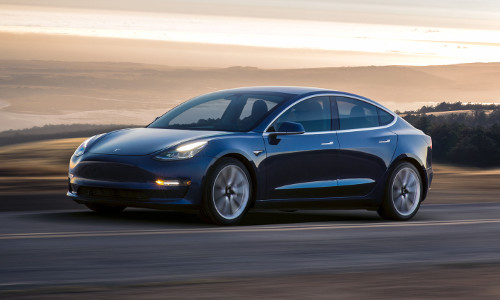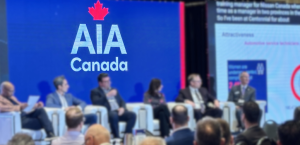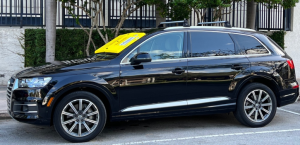By Jeff Sanford
Toronto, Ontario — November 28th, 2017 — This week’s Tuesday Ticker: Axalta’s good fortune, FinishMaster’s plan, the return of semi-manufacturing to Ontario, and much, much more!
The biggest market news of late, of course, has been the game of musical chairs being played among global paint manufacturers. Nippon Paint made an all-cash offer last Tuesday to acquire US coatings company Axalta Coating Systems. The story is being widely covered in the business press. At the beginning of last week Axalta was talking to Dutch paint maker AkzoNobel about a possible merger. Those talks ended when the Nippon offer came in. Axalta’s share price rose as a result. That will be welcome news for Axalta’s single largest shareholder Warren Buffett’s Berkshire Hathaway Inc. Nippon Paint is Japan’s biggest paint supplier and is 39 per cent owned by Singapore-based investment company Wuthelam Holdings Limited according to a media report. Nippon is bigger than Axalta. Axalta has a market capitalization (the total value of all issued shares) of around $8.2 billion, Nippon Paint about $10.7 billion.
Nippon Paint shares fell when the offer was announced. The company is headquartered in Osaka. It has, according to the reports, “… expressed a desire to expand in the United States and Europe to become a ‘global paint major’.” This past spring Nippon bought US paint manufacturer Dunn-Edwards for USD $608 million. According to a Japanese analyst quoted in a media report, an Axalta deal would help the company “crack open the US market and boost earnings from automotive coatings.” As for AkzoNobel, that company spurned offers from PPG earlier this year. PPG could make a new offer in December. The company is on a “cooling off” period mandated by Dutch law. The CEO of PPG has been quoted as saying the company is no longer interested in AkzoNobel. AkzoNobel management said in a press release the company would go ahead with its plan for, “… selling or seeking a stock market listing for its specialty chemicals division.” This past week AkzoNobel announced it will acquire a smaller company called V.Powdertech, as a way of strengthening its powder coatings business in South East Asia. V.Powdertech is a Thai manufacturer of powder coatings. According to the press release, “The acquisition of V.Powdertech will bring new technologies and services to complement AkzoNobel’s global technology portfolio and business in market segments such as… automotive coatings. The transaction includes all relevant technologies, patents and trademarks, as well as a manufacturing plant in Samutsakhon, Thailand.” The transaction is expected to be completed within the coming weeks, according to the press release.
Quebec-based product distributor FinishMaster released its latest financials recently. A report in the auto aftermarket trade press discussed the company’s strategy going forward. The company’s earnings report for the third quarter showed that FinishMaster’s organic growth had slowed dramatically, falling more than 8 per cent. According to the company one percent of the decline is a result of hurricane’s Irma and Harvey. 6 per cent of the decline is a result of a product changeover.
Shops should be on the lookout for a “sales push from the jobber” as it works to turn that trend around in the year to come. “We will be in positive territory in 2018” on organic growth, FinishMaster CEO Steve Arndt was quoted as saying. According to the story, FinishMaster will try to, “… boost the business it does with shops. FinishMaster also blamed collision repair consolidation for its diminished margins in the third quarter, though it noted that a cut in ‘performance-based compensation’ helped to cushion the blow. Arndt… “explained that MSOs buying out FinishMaster’s traditional customers ends up being worse for Uni-Select from a margins perspective… FinishMaster’s gross margins fall as the MSO can command a larger discount than the smaller shop it acquired.” The company announced an initiative to take $20 million in costs out of the company. The so-called 20/20 Inititative will, “… examine the cost of all types of collision repair customers and ensure FinishMaster can still be profitable with MSO margins which are ‘obviously less’.” According to a release from the company, “FinishMaster US is working on organic sales initiatives coupled with productivity improvement initiatives focused on reducing its costs to serve [these] model.” The release went on to quote management as saying, “The current acquisition strategy remains in place; acquiring companies to expand its geographic coverage as well as building density in key markets. Over the coming quarters, FinishMaster US will remain focused on the successful integration of the acquired businesses into its group, driving expected synergies and providing superior service to more customers. Organic growth remains a top priority with teams focusing on all segments, including traditional collision repair centres, regional and national customers and MSOs.”
Tesla is burning huge amounts of money as it struggles to produce its Model 3. According to the Wall Street Journal Elon Musk’s electric car company is burning through USD $8,000 ($10,000 CAD) a minute, or USD $480,000 ($612,000 CAD) an hour. The company is currently drawing down its credit facilities to keep production going. There is not enough cash in the company to survive another year. A former head of GM claimed the company is in a debt-based death spiral. A Bloomberg analyst notes, “Whether they can last another 10 months or a year, he needs money, and quickly.” The company will have to raise at least USD $2 billion in fresh capital by mid-2018 according to the analyst. Tesla’s stock has fallen by 20 per cent since it hit record highs this past fall. In a recent conference call with analysts, Musk suggested everything is fine at the company. “Five years ago we had only delivered 2,500 cars, so the Tesla fleet has grown by a factor of 100 in five years. I would expect five years from now to be at least an order of magnitude beyond where we are right now and possibly even close to two orders of magnitude. But for the skeptics out there, I’d like to say – ask them which one of you predicted that Tesla would go from 2,500 units delivered to 250,000 units delivered now. I suspect the answer is zero. So consider your assumptions for the future and whether they’re valid or perhaps pessimistic… So for Model 3, we continue to make significant progress each week. We’ve had no problems with our supply chain or any of our production processes. Obviously, there are bottlenecks. There are thousands of processes in creating the Model 3, and we will move as fast as the slowest and least lucky process among those thousands… we expect to achieve a production rate of 5,000 Model 3 vehicles per week by late Q1 2018, so probably sometime in March. I think in the grand scheme of things this is a relatively small shift, the Model 3 is a 10-year program, and so we’re talking about a few months out of a 10-year program. It’s in the grand scheme of things…[according to a] net present value calculation, this is immaterial… We understand the bottlenecks… the design intent of the Model 3 being that its design manufacturability is turning out to be accurate, it is far easier to build this car than a Model S, and vastly easier than a Model X. The primary production constraint really, by far, is in battery module assembly.”
Even as the company struggles to make money, this past week Tesla introduced two new models, a roadster and a semi. Musk claimed the truck will be able to travel at highway speeds for 500 miles, far beyond the 220 miles any electric truck has yet accomplished. According to Bloomberg New Energy Finance, “… even if Tesla achieves record-breaking efficiency for the truck, it would still require a battery capacity somewhere from 600 kilowatt hours to 1,000 kilowatt hours to deliver on Musk’s claims… According to an analyst, “Tesla’s cumulative [capital expenditure] announcements now exceed $15 billion to $20 billion over the next few years.” Another analyst was quoted as saying about the new model announcements: “In essence, all last night’s event did was add to Elon Musk’s shopping list of things he needs to spend money on at a time when the company is having difficulty making its
base vehicle (Model 3).” In the case of the roadster, the company began taking $50,000 deposits for a car it won’t introduce until 2020. The technology is not quite ready to support the vehicles introduced this past week, according to experts. Musk must be, “… banking on battery improvements between now to the early 2020s in order for its truck to make financial sense,” according to one story. The Roadster would need to pack a massive 200-kilowatt-hour battery that is twice the size of any battery Tesla currently has on the road to achieve stated performance claims. Current technology is such that the, “… batteries required would be too large to fit in such a small frame, as on display last week. Is Musk trying to maintain some hype around the company as it hustled to solve its production problems? That could be one interpretation of the week’s events. Says the electric vehicle analyst for Bloomberg New Energy Finance. “I don’t understand how that works. I really don’t… I really don’t think the car you saw last week had the full 200 kilowatt hours in it. I don’t think it’s physically possible to do that right now.”
BYD Company is a Chinese electric-vehicle maker backed by Warren Buffett. A report from the Financial Post this past week notes the company plans to open its first assembly plant in Canada. According to the report the company anticipates a surge in demand for electric trucks, “… from municipalities and businesses.” The story goes on to say BYD is often described as China’s Tesla, and will open the plant next year in Ontario and hire about 40 people to start. The story quotes a BYD Canada spokesman as saying the Shenzhen-based company has decided to “significantly” accelerate its investment in Canada as growing demand for electric vehicles and provincial tax incentives create a more welcoming environment than the US in the short-term. “There is less of a barrier to entry when it comes to having Chinese products in Canada compared to the US,” according to the source. The company thinks the time to move is now. The UK and France plan to ban sales of diesel and gasoline-fuelled cars by 2040. Canadian provinces are offering thousands of dollars in rebates to electric-vehicle buyers. Major organizations like Loblaws are looking for electric vehicles to do local delivery. BYD plans to begin operations in Ontario by, “… shipping technology and components from China and making short-range vehicles such as garbage and delivery trucks… The company intends to expand, hiring more people to add more Canadian content in the future. According to the source, “BYD is a global company, but we like to localize. It doesn’t make sense to build everything in China and then ship it. It makes more sense to utilize the incentive programs and policy changes and create jobs in different markets.” As well, a core attraction for Ontario is that the, “… region around Toronto has many distribution centres within close proximity, so if one company goes electric and sees their costs reduced, other companies will start doing it too… If successful, BYD could be at the forefront of rebuilding a dormant truck-manufacturing industry.” Or, as the source said, “We’re bringing back an industry and we’re doing it through electrification. It’s a totally different game.”





































